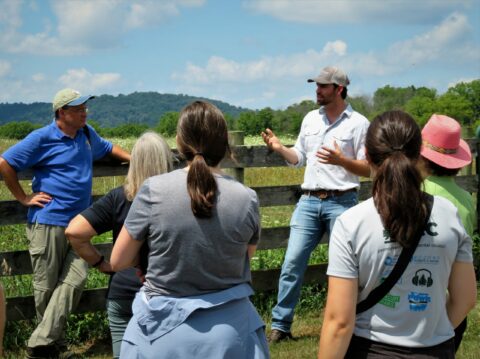
We’ve heard the voices of frustration and challenges about how long it takes to create a productive network, alliance, or partnership. And the questions come – How long will this take? Why can’t we move faster? Is this worth it? Will this actually work?
I’d been pondering these types of challenges when I had a light bulb moment of revelation in the early fall. The Institute for Conservation Leadership (ICL) had the opportunity to organize a networking event for the Delaware River Watershed Initiative that included a tour of Cotton Cattle Company.
Bryce Cotton is part of this fourth and fifth generation family farm near Asbury, NJ. With a beautiful pasture and the low mountains of the NJ Highlands as a backdrop, Bryce described to our group their shift to regenerative agriculture:
We saw it as a new and exciting idea that has the potential to make a large-scale change. It was easy to get caught up in the idealism of the work and vision. We believed we could benefit the environment and make a living.
But we had to figure out how it worked at scale and if we could grow it to a level that works as a business. We wanted to not have it end with me, but to create something that would work for several generations down in my family.
And then he said the thing that made the light bulb pop for me.
We might have quit there at years 3, 4, or 5. Honestly, many farmers would have walked away. And if we had, we would have been months away from our big breakthrough when our profits began to take hold.
That sentiment parallels what we see in building collaboration.
In a follow-up interview, Bryce offered his broader perspective and approach to regenerative farming. To my ears, what he shared about farming also sounded like a master class in lessons for building successful collaboration:
Foundational work is essential. You build and you spend the time at the beginning, down in the ditches, and build the foundation out of all the pieces you want to put in place.
We had to grow slow and steady, and we went very slow in the beginning. We took the time to filter through who was going to help us get all the goals we wanted.
It’s so pervasive now – everything on social media drives us to have an expectation that we can get things done easy and fast. Things of long-term value take time. We tried to look at it in a 5-to-10-year horizon.
We have relied on the team approach—I’m always calling our partners and checking in because we need them. We depend on the conservation folks, all the way to the butchers and processors, the distribution folks, and those delivering it to the customer without a wild amount of overhead.
You want to be the one your partners will call – you have to treat your partners really well. Build trust and relationships – that is where the payoff will come from.
We had to take the time to try things, to make the mistakes. We had to be able to deal with the slow and dark times.
Based on this learning and sage approach, the Cotton Cattle Company has shifted to rotational grazing, riparian buffering, and conservation mowing. This shift has yielded significant results – enhanced soil fertility, increased water quality, and a hot spot for NJ grassland bird species. And, most importantly, it is a business model that has 70 to 80% repeat customers and a profit margin that can support their family.
The Water Center at Penn surveyed eight water-related networks in 2019. In their research paper summarizing the interviews they noted many of the same themes that Bryce Cotton named. They especially called out the number of years it took to form each network. The collaboration formation time ranged from 6 months to 8 years and averaged 3.5 years. And they noted that the one collaboration that formed in only 6 months ended after 2 years.
Based on this research, our experience, and the lessons from regenerative agriculture, we encourage you to build or even re-build your collaboration well. Then, wait for the breakthroughs.
This post by Dianne Russell of ICL originally appeared on their blog. Thank you to the ICL team for the repost!